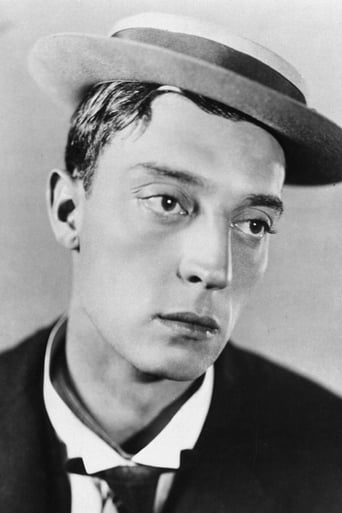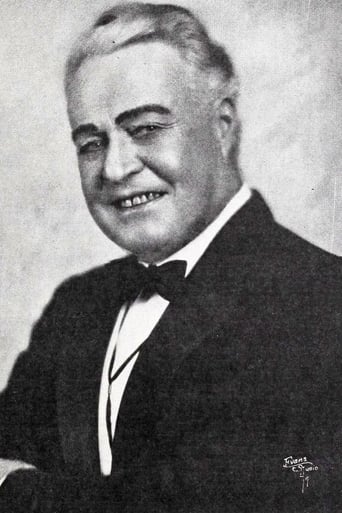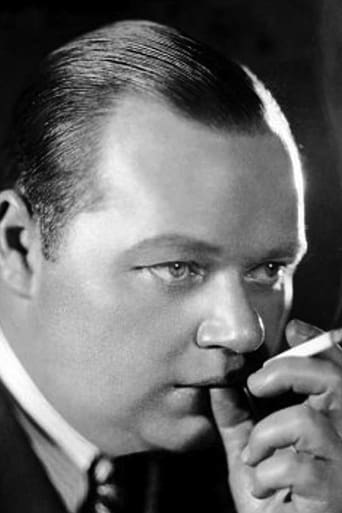wes-connors
Indiana transient Buster Keaton (as Homer Holiday) is unable to make friends or hold a job. Even dogs walk away when he pets them. Trampled and downtrodden, Mr. Keaton decides to "Go West" and start a new life. He hops a train. He hops a horse. Keaton finds the western life more agreeable and begins working as a ranch-hand. His first job is to milk a cow named Brown Eyes. Buster puts the pail in the right place but expects the milk to pour out, unassisted. Despite this beginning, Buster and Brown Eyes bond. Their scenes together are sweet, with the cow allowing us to see a rarer side of Keaton's stock character. As a love interest, she functions better than female co-stars like Kathleen Myers...A memorable scene without Brown Eyes involves Keaton at the typical western card table poking fun at the classic line, "When you call me that, smile" (from 1902's "The Virginian"). The only way a stone-faced Keaton can "smile" is by employing the method used by Lillian Gish in D.W. Griffith's "Broken Blossoms" (1919). In a scene wearing that much eye make-up, Keaton is wise not to smile. Also worth catching is Keaton dressed as the Devil leading a herd of cattle through the streets of Los Angeles. "Some people travel through life making friends where ever they go, while others just travel through life," a prelude advises. This isn't the best of Keaton's great 1920s streak of classics, but it may be the friendliest.******* Go West (10/25/1925) Buster Keaton ~ Buster Keaton, Kathleen Myers, Howard Truesdale, Ray Thompson
imogensara_smith
There is a fundamental disagreement about Go West, between those who see it as Keaton's only sentimental movie, and those who think Buster is satirizing sentimentality. I'm in the latter group. Keaton's satire is so subtle, and so devoid of meanness, that people easily miss it—but I'm convinced he's playing the whole opening sequence with tongue firmly in cheek. His character, "Friendless," is just a shade too pathetic to take seriously; even a dog turns away coldly when he tries to pat it. Buster is not appealing for pity here, he's getting in a gentle dig at other performers (particularly, perhaps, one whose initials were C.C.) who did.In a later scene, mooning over a girl who won't give him the time of day, Buster leans wistfully against the edge of a well. His elbow knocks the bucket into the well, the rope unspools and the handle, spinning, clunks him smartly on the head. Don't feel sorry for me, he is saying: laugh at me. Buster's screen character is a stoic (as he was off-screen), and his sense of humor is part of his stoicism. His insistence on seeing the comedy even in painful and humiliating situations is the inexhaustible source of his dignity.Buster had a natural rapport with animals. He shares their mute patience: "They do not sweat and whine about their condition," as Walt Whitman wrote, and neither did he. The heart of Go West is the touching—though faintly ridiculous—friendship between Friendless and Brown Eyes, a pretty little Holstein cow who is ostracized by other cows on the ranch where Friendless works as a hand. Buster trained Brown Eyes himself, and she follows him around with endearing, dopey devotion. In one of the film's best sight gags, he ties a pair of antlers on her head so that she can defend herself against horned steer. She looks like a seriously overweight reindeer. The plot is driven by Friendless's efforts to save Brown Eyes from being sent to the slaughterhouse with the rest of the cattle, and to save his employer from financial ruin. He shows some interest in his employer's attractive daughter, but not a whole lot; poor Kathleen Myers is left with little to do, and looks a bit miffed at playing second fiddle to a cow.Go West is easily Keaton's oddest film, and it's not entirely successful. There's a limit to how much comedy you can get out of cows. Where Buster got the idea of making a movie that centers around cattle I don't know (though I do think "Brown Eyes" is a joke about the devoted, cow-eyed leading ladies featured by some other comedians.) But once he got an idea, Buster always explored it thoroughly and carried it as far as it would go. He dreamed up a promising finale: a herd of cattle turned loose in the streets of Los Angeles. Unfortunately, as he himself later said, it didn't work out as planned. There's an enjoyable zaniness and surrealism to the spectacle, but it's all a little overplayed, Mack Sennett style, which is uncharacteristic for a Keaton movie. Even more atypically, he fakes the final stampede by speeding up the film: it just wasn't possible to get the cows moving fast enough to provide a satisfying final chase.The earlier part of Go West, however, contains a number of beautifully Keatonesque moments: his attempt to adopt a bowlegged walk to look like an old cowboy, the elegantly summarized sequence where he rides the rails, the perfect timing of the supper table scenes, in which Buster repeatedly arrives just as everyone is leaving, then finally "turns the tables." Just hired at the ranch, Buster is handed a pail and stool and told to milk a cow. He approaches the cow, places the pail under her udders, sits down a discreet yard away and waits for the cow to do her thing. When nothing happens, he takes the pail and shows it to the cow, in case she didn't notice it was there, puts it back and keeps waiting patiently. Playing it straight, never italicizing his jokes, finding comedy in stillness and in not reacting, a comedy of negative spaces, is the essence of Keaton's style. He never "milks" his gags—not even this one.In my favorite scene, Buster pokes fun at his own "stone face" persona. He's playing cards with a couple of tough cowboys and accuses one of cheating. The cowboy pulls out his six-gun, levels it at Buster, and orders, "When you say that—SMILE." Buster's reaction is one of his subtlest and most ineffably hilarious close-ups. He pauses; he ponders—not whether to smile, but how to get out of the jam since he CAN'T smile. He tries out the Lillian Gish, Broken Blossoms bit of pushing the corners of his mouth up with his fingers. Not good enough. He sighs. Then a crafty determination creeps into his eyes. He insinuates his pinky behind the cowboy's trigger finger, and with all his strength keeps him from squeezing the trigger while he pulls out his own tiny gun (which, for convenience, he has attached to a string like a child's mitten) and makes the guy back down. Not smiling is a matter of life and death.
butterfinger
I suppose Go West is an uplifting story-a young, goodhearted working man makes a living in the west-and I like the comparison between city and country life, but there is no heart in this film. It is stiff and cold. Even Buster Keaton himself (as the cowboy) lacks his earnestness and lack of confidence. Or maybe he doesn't-it's hard to tell since we rarely get to see clear shots of his face. This is a shame since what makes Keaton so good is not his visual grace so much as his nervous facial expressions while pulling off his stunts. Here we have action but no reaction. Even the action isn't very good; the only scene of real physical mastery is one where Keaton is tumbling around in a boxcar full of barrels; once again, the scene stinks because we never get to see his face. Even the attempt at adding a romance to the film is downright awful because it feels stapled on. One somewhat funny scene involves a crazed gunman trying to get Keaton to smile (you can imagine how reluctant he is) but the scene is a blatantly annoying wink to Keaton's persona and feels like a commercial for Keaton's work rather than a good old-fashion silent comedy riff. Buster Keaton is one my favorite comedians (probably my favorite silent comedian) but he has a handful of incomprehensibly popular trash such as Steamboat Bill Jr., Seven Chances, and-I would hate to have to add it too the list but-Go West.







